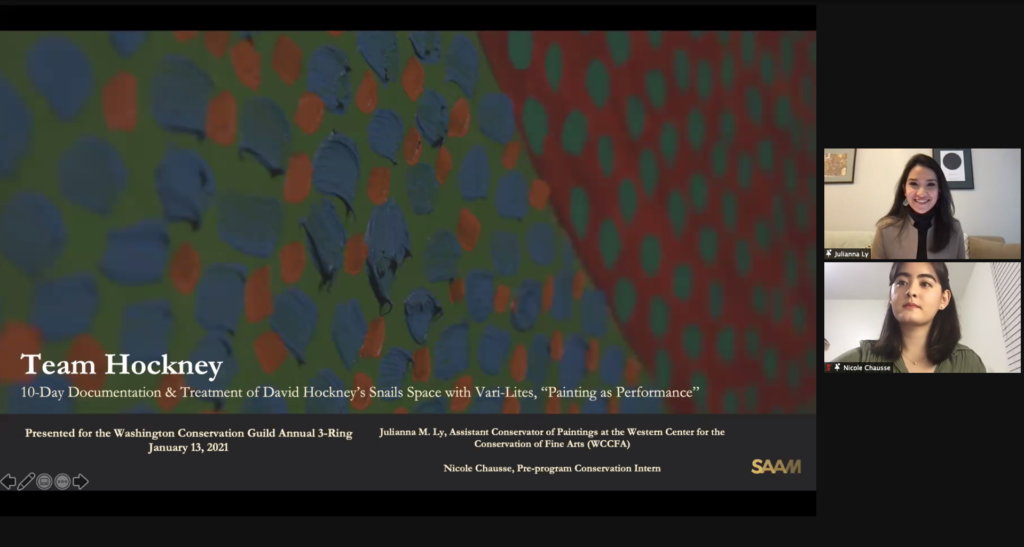Team Hockney: 10-Day Documentation & Treatment of David Hockney’s Snails Space with Vari-Lites, “Painting as Performance”
Speakers:
- Julianna Ly, Assistant Conservator of Paintings at the Western Center for the Conservation of Fine Arts (WCCFA)
- Nicole Chausse, Pre-Program Conservation Intern
Summary by Emma Kimmel, Graduate Intern in the Department of Painting Conservation at the National Gallery of Art
Attendance: ~ 85 people

As part of the WCG’s Virtual Two-Night Circus hosted on Zoom, Julianna Ly and Nicole Chausse presented their collaborative work documenting and treating David Hockney’s Snails Space with Vari-Lites, “Painting as Performance” at the Smithsonian American Art Museum (SAAM). This daunting project was completed over the course of 10 days and was done in situ in the public view. Their presentation detailed their efficient approach to documenting and treating such a large artwork – over 21 feet in length – while engaging visitors throughout.
Hockney’s piece posed many challenges for treatment. Not only is it an extremely large artwork, but it is also covered with about 1000 wooden dowels. Ly and Chausse outlined a long history of incident reports for this artwork, many of which were in reference to misplaced dowels – probably the result of interaction with the public. Their major goal was to document the condition of the painted surfaces and the wooden dowels. As such, they divided the painting into several designated regions that would make condition reporting more manageable and understandable moving forward. This system was then carried through to customized condition survey forms which made notations more straightforward.
The actual treatment, while in most areas was fairly straightforward, was complicated by the sheer number of dowels and square feet to cover. Days 1 and 2 of the project were devoted entirely to photo documentation and removal of the dowels, followed by a collective survey of the work to identify major condition issues before filling out the condition survey forms. The painting was executed in acrylic paint, which required dry cleaning and localized removal of wax residue from prior treatments to reattach dislodged dowels. Across the two canvases that make up this monumental artwork, the major condition issues they noted were cracking in areas of impasto and small paint losses. They then created an assembly line to dismount, surface clean, remove wax, stabilize, and remount each individual wooden dowel. Hockney did not specify a location for each individual dowel, so their exact location did not need to be regarded for remounting. This work understandably occupied the remaining 8 days of the project timeline.
Ly and Chausse concluded their presentation with their thoughts on the benefits of working in the public eye. They were enthusiastic about their ability to engage with the public, and in particular. speaking with school groups of all ages. Everyone helping with the project took turns manning SAAM’s “À La Cart” Art Cart stationed in front of the artwork where they could give impromptu tours to interested visitors. Public engagement helped those on the project to develop skills beyond just treatment work and allowed them to share their own passion and knowledge about this piece and conservation work generally. They hope that their efforts helped visitors to feel more welcomed and engaged during their time at SAAM.